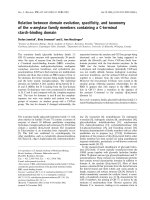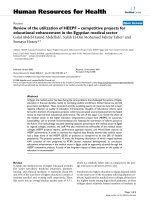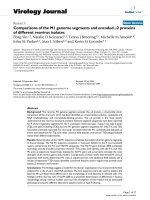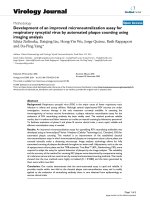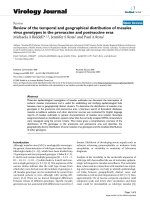Báo cáo sinh học: "Review of "Reconstructing Evolution: New mathematical and computational advances" edited by Olivier Gascuel and Mike Steel" potx
Bạn đang xem bản rút gọn của tài liệu. Xem và tải ngay bản đầy đủ của tài liệu tại đây (172.86 KB, 2 trang )
BioMed Central
Page 1 of 2
(page number not for citation purposes)
Algorithms for Molecular Biology
Open Access
Book report
Review of "Reconstructing Evolution: New mathematical and
computational advances" edited by Olivier Gascuel and Mike Steel
Andreas Spillner
Address: School of Computing Sciences, University of East Anglia, Norwich, UK
Email: Andreas Spillner -
Book details
Gascuel O, Steel M: Reconstructing Evolution: New mathemati-
cal and computational advances Oxford University Press, New
York; 2007. hardcover, xxix + 318 pages ISBN 978-0-19-
920822-7
Overview
The main theme of the book is mathematical models of
evolutionary processes in biology. These models have
become increasingly complex in order to cope with the
various aspects involved in the study of these processes
and involve a wide range of concepts from different areas
of mathematics and computer science. This book gives an
overview of some of the key contemporary topics in the
field. The book is organized in 10 chapters, each written
by an expert or a group of experts on the topic addressed
in that chapter. At the end of many chapters directions for
future research are discussed. Each chapter comes with its
own list of references. At the end of the book the reader
can find an index that helps to locate quickly the context
within which a particular concept appears.
Contents
The book starts with a brief introduction by the editors.
They outline how the discovery of biological processes
such as alternative splicing and lateral gene transfer have
changed our view of evolution and how this has led to
very complex models of evolutionary processes in biol-
ogy. The editors emphasize that a better understanding of
these processes is of great value for solving problems such
as the prediction of protein function from genomic
sequences or biodiversity conservation planning.
The first two chapters are grouped together under the
headline Evolution in Populations. Chapter 1, by J. Felsen-
stein, first reviews the basic concept of coalescents, that is,
trees that describe the ancestral relationship between cop-
ies of genes formed in populations. Next, to obtain a more
realistic model, the effects of population growth, migra-
tion, recombination and natural selection are taken into
account. Then, inference methods based on the model are
reviewed and at the end of Chapter 1 the reader can find a
list of available coalescent programmes. Chapter 2, by A.
Rodrigo et al., is centered around the concept of measura-
bly evolving populations, that is, populations for which
sequence data is obtained over time and a significant
accumulation of substitutions is found. The authors
review methods for constructing evolutionary trees and
estimating quantities such as substitution rate, popula-
tion size and migration rate under these circumstances.
Chapters 3 and 4 are dedicated to Models of Sequence Evo-
lution. The first part of Chapter 3, by O. Gascuel and S.
Guindon, addresses the issue of variability of sequence
evolution, and the reader can find an extensive overview
of existing models that take this variability into account.
In the second part of the chapter, two data sets are used to
illustrate how these models can be employed to analyze
sequence data. In Chapter 4, by E. S. Allman and J. A.
Rhodes, the concept of phylogenetic invariants is reviewed.
The authors provide the reader with the necessary basic
terminology from algebraic geometry and then explain
how such invariants can be found and how they can help
to better understand models of sequence evolution.
Chapters 5 and 6, Tree Shape, Speciation, and Extinction,
focus on how to model diversification and assess biodi-
versity. In Chapter 5, by A. O. Mooers et al., several mod-
els are discussed for generating trees. The goal is to
Published: 6 November 2007
Algorithms for Molecular Biology 2007, 2:14 doi:10.1186/1748-7188-2-14
Received: 16 October 2007
Accepted: 6 November 2007
This article is available from: />© 2007 Spillner; licensee BioMed Central Ltd.
This is an Open Access article distributed under the terms of the Creative Commons Attribution License ( />),
which permits unrestricted use, distribution, and reproduction in any medium, provided the original work is properly cited.
Publish with BioMed Central and every
scientist can read your work free of charge
"BioMed Central will be the most significant development for
disseminating the results of biomedical research in our lifetime."
Sir Paul Nurse, Cancer Research UK
Your research papers will be:
available free of charge to the entire biomedical community
peer reviewed and published immediately upon acceptance
cited in PubMed and archived on PubMed Central
yours — you keep the copyright
Submit your manuscript here:
/>BioMedcentral
Algorithms for Molecular Biology 2007, 2:14 />Page 2 of 2
(page number not for citation purposes)
generate trees whose shape is similar to that of evolution-
ary trees constructed from real biological data and,
thereby, to better understand the processes that lead to the
patterns found in those trees. Chapter 6, by K. Hartmann
and M. Steel, reviews a measure used in conservation
planning called phylogenetic diversity (PD). After present-
ing some of the mathematical properties of this measure
it is compared to other measures of biodiversity and issues
like the time scale for planning or budgetary constraints
are discussed. The chapter concludes with some statistical
properties of PD and its application in the reconstruction
of evolutionary trees.
Chapters 7 and 8 are devoted to problems arising in the
context of the reconstruction of Trees from Subtrees and
Characters. In Chapter 7, by M. J. Sanderson et al., the
problem of fragmentation of the data in large scale phylo-
genetic analysis as addressed and strategies to deal with
this problem are discussed. The problems studied in
Chapter 8, by S. Grünewald and K. T. Huber, arise from
the question: When does a data set support an evolution-
ary history that is tree-like? After formalizing this ques-
tion, a collection of well known and also more recent
combinatorial results that answer this question is
reviewed, including characterizations of phylogenetic
trees in terms of chordal graphs and closure rules.
The last two chapters, From Trees to Networks, are moti-
vated by the fact that the evolutionary history of some sets
of taxa is better represented by a network rather than a
tree. Chapter 9, by D. Huson, first gives a short overview
of which types of networks are currently used to represent
biological data. Then several methods for computing such
networks are reviewed. In Chapter 8, by C. Semple, the
basic problem is to find a network that can explain the
biological data involving a minimum number of hybridi-
zation events. A characterization of such networks as well
as the connection to several related optimization prob-
lems along with their computational complexity is dis-
cussed.
Summary
In my opinion the book has achieved the goal of the edi-
tors to give a detailed overview of key topics in molecular
evolution. As with any selection of topics, especially in a
field developing as rapidly as phylogenetics, there are cer-
tainly topics that have not been addressed but are (or
soon turn out to be) of equal importance such as, e.g., the
simultaneous construction of sequence alignments and
evolutionary trees. The material that is covered in the
book can serve as an entry point which leads the reader
quickly to the relevant literature and also provides some
help for how different approaches to a particular problem
compare to one another. It is certainly not a textbook and,
depending on the topic, requires a good deal of back-
ground knowledge. Depending on this background
knowledge, some readers aiming to understand in depth
the methods and results discussed will probably need to
consult the original papers. In conclusion, the book can
serve as a very good reference for researchers in the field
and to some extent as a source where the reader searching
for an appropriate method to analyze a particular data set
can find some guidance.
